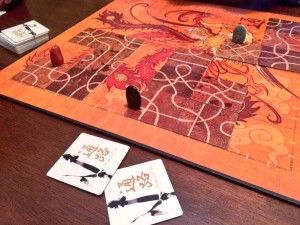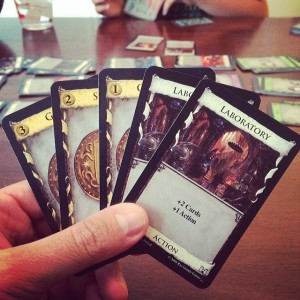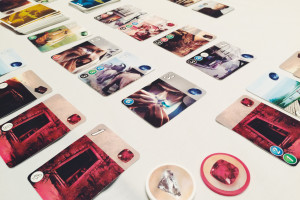Family Game Night: A Few Recommendations
I still have a post or two left in my series recapping our Wyoming adventure this summer, but I thought I would take a short break to share a few more family board game recommendations, just in time for the holidays. See my earlier posts for additional recommendations, including favorites like Sleeping Queens, Love Letter, and Forbidden Island, as well as Ghost Blitz, Mysterium, and Mice & Mystics.
 Tsuro (Calliope Games) – We don’t actually own Tsuro (yet), but the girls played it last month at a game night I hosted. I usually schedule game nights for weekends the girls aren’t with me, but they had been asking to come to a game night, so I made it happen. The girls had a good time playing with my friends, and their favorite new game of the evening was Tsuro by Calliope Games.
Tsuro (Calliope Games) – We don’t actually own Tsuro (yet), but the girls played it last month at a game night I hosted. I usually schedule game nights for weekends the girls aren’t with me, but they had been asking to come to a game night, so I made it happen. The girls had a good time playing with my friends, and their favorite new game of the evening was Tsuro by Calliope Games.
Tsuro is a beautiful abstract game. It’s played on a large grid. Everyone starts their pawns at the edge of the board, then take turns laying down tiles that create paths for their pawns to follow. The goal is to keep moving along the path you started, by following that path from one tile to another. If your pawn’s path leads to some edge of the board, either because you had to play a tile that creates such a path or because someone else plays a tile that alters your path, you’re out. Last pawn still moving wins.
There’s a bit of long-term strategy involved in Tsuro, but mostly it’s short-term tactics. You have a hand of three tiles to choose from, so you can plan your next couple of moves, trying to build a path that keeps you away from other players and doesn’t run into the edge of the board. It’s neat to see how the winding paths connect, and it’s even a little fun to lose, as you move your pawn along some crazy path that ends your journey. Both of my girls (ages 7 and 12 now) got the hang of the game very quickly and had a lot of fun building paths and watching pawns move all over the board.
Tsuro can handle a lot of players, up to 8 total. It’s rated ages 8 and up, but I bet a clever 5- or 6-year-old could play. It’s a fairly short game, too, maybe taking 15 to 20 minutes, depending on how long the players take to consider their moves. But you’re not going to play just once, so plan accordingly! Tsuro is definitely on my Christmas list this year.
 Sushi Go! (Gamewright) – I spotted this small-box card game at Target a while back. The smiling sushi on the front of the box drew me, but it was the game mechanics that sealed the deal. Sushi Go! is a simple, fun “pick and pass” card game with a cute theme.
Sushi Go! (Gamewright) – I spotted this small-box card game at Target a while back. The smiling sushi on the front of the box drew me, but it was the game mechanics that sealed the deal. Sushi Go! is a simple, fun “pick and pass” card game with a cute theme.
The game comes with a big deck of cards, each displaying a particular kind of anthropomorphic sushi. Each player is dealt a hand of cards, then selects a card from the hand to keep. Players reveal their choices simultaneously, then everyone passes their hand to the player to the left. This process repeats, with the same hands of cards moving around the table, getting smaller each turn, until all the cards are divvied up. You score points by collecting sets of cards. If you get two tempura cards, you get 5 points. Three sashimi are worth 10 points. Your first dumpling is worth 1 point, but collect two and they’re worth 3 points. Three dumplings will score 6 points, and four dumplings will net you 10 points. And so on. You play three rounds like this, and the player with the most points at the end is the winner.
Card drafting and set collection are two mechanics that show up in a lot of modern tabletop games (7 Wonders, for instance), and Sushi Go! makes for an accessible (and adorable) introduction to these mechanics for younger players. My kids picked up the rules very quickly, although it took a few plays before they started to develop strategies to be competitive. I should add that the seven-year-old sometimes get a bit frustrated while playing, since it’s easy for another player to nab a card she had her eye on.
Sushi Go! is for 2 to 5 players, and games go quickly, 15 minutes tops once you’ve learned how to play. It’s rated ages 8 and up, and I wouldn’t recommended it for much younger kids, given the “take that!” factor that sometimes upsets my younger daughter. The game also takes a little memory work and some longer term planning, since the hands you start with will come back around a couple of times before the round is over, so ages 8 and up sounds about right.
 Dominion (Rio Grande Games) – Dominion won a ton of awards when it came out in 2009, including BoardGameGeek’s “Golden Geek” award and Germany’s very prestigious Spiel des Jahres. It’s a very clever game, but it’s not one that I expected my girls to like as much as they do. We played it many times during the summer of 2014, when I bought it, and the girls still ask to play it from time to time even now.
Dominion (Rio Grande Games) – Dominion won a ton of awards when it came out in 2009, including BoardGameGeek’s “Golden Geek” award and Germany’s very prestigious Spiel des Jahres. It’s a very clever game, but it’s not one that I expected my girls to like as much as they do. We played it many times during the summer of 2014, when I bought it, and the girls still ask to play it from time to time even now.
Dominion is a deck-building game. Each player starts with a standard ten-card deck. On your turn, you draw a hand of five cards and use those cards to purchase more cards for your deck from a common pool. At the end of your turn, you discard your entire hand, plus those new cards you bought, and draw a new hand of five cards. If your draw deck runs out of cards, you shuffle your entire discard pile to make a new draw deck and continue. This means that the cards you buy will show up in again in future hands. In this fashion, you “build” your deck as you go, adding different kinds of cards you can play on your turn or victory-point cards that determine the winner at the end of the game.
This sounds complex, and indeed most new players find Dominion’s mechanics a little nonintuitive. “Wait, do I discard my entire hand?” “So these victory-point cards don’t do anything useful until the end of the game?” “I take my entire discard pile and shuffle it into my draw deck? On the third turn of the game?” But after about five minutes, the game makes sense, even if it’s not clear yet what kind of strategy will win the game. It’s Dominion’s novel game mechanics, as well as how well those mechanics were executed, that led to all those awards.
My girls love Dominion because it’s fun to figure out combinations of cards that work really well together. Each time you play, you choose 10 of the 25 available action cards to create the common pool (from which you purchase cards for your deck), so there’s a ton of replay value (technically, over 3 million possible game configurations) and lots of opportunities to figure out card combos. The girls will often hit upon card combos that never occurred to me! Also, there’s something satisfying about building up an effective deck one card at a time. We like the game enough that we bought an expansion for it (Dominion: Prosperity) that adds even more possibilities… over 10 billion game configurations!
Dominion is rated ages 13 and up, but my seven-year-old has no problems playing. Each of the action cards in the game has a different effect, so there’s some text to read and remember. But you’re only using 10 action cards at a time, so it’s not too much text. The box says that the game takes 30 minutes, but that assumes adults who are making fairly quick decisions and building effective decks as they go. With the kids, Dominion tends to run closer to 45 minutes or an hour. It’s good for two to four players.
 Splendor (Asmodee) – I played Splendor at a local board game convention last spring. After three plays, I was hooked, and I ordered the game sometime that next week. Splendor won the 2014 BoardGameGeek “Golden Geek” award, and for good reason. It’s elegantly and attractively designed, easy to learn and fun to play, and just a bit addictive.
Splendor (Asmodee) – I played Splendor at a local board game convention last spring. After three plays, I was hooked, and I ordered the game sometime that next week. Splendor won the 2014 BoardGameGeek “Golden Geek” award, and for good reason. It’s elegantly and attractively designed, easy to learn and fun to play, and just a bit addictive.
In Splendor, you take on the role of a gem collector. On your turn, there are just a few things you can do. You can take a few multi-colored chips from a common pool, or you can spend your accumulated chips to buy a card (a gem) from the middle of the table, or you can put a card on reserve to buy later. Some cards are worth victory points, and the first player to 15 points wins. (Technically, they trigger the final round, and the player with the most points at the end of the round wins.) Here’s the clever part: All the cards have a color and count as permanent chips of that color. That way, you can build your buying power over time, allowing you to pick up the higher point value cards you need to win. Also, if your card (gem) collection is impressive enough, you’ll attract the attention of a noble, each of whom is worth three victory points.
The girls picked up the rules of Dominion in no time, and they enjoy the “engine” aspect of the game, that is, using early purchases to build up to later, more valuable purchases. The cards and other components are beautifully designed, but the game itself is a little abstract. I think that’s why the seven-year-old likes it better than the twelve-year-old, who prefers games that have stronger themes and stories. The seven-year-old is definitely a fan. At Thanksgiving this week, she requested we play it with the extended family and she didn’t want to be my “helper,” she wanted to play by herself. Speaking of the extended family, my brother-in-law had the same experience I did upon first playing Splendor: He’s planning to buy it himself ASAP!
Splendor is rated ages 10 and up, but my five-year-old nephew was picking up the mechanics while watching his dad, so I think younger kids, especially ones with a little mathematical aptitude, would enjoy it. I go a little easy on the kids when I play, which keeps things fun. Splendor is for two to four players, and it plays very well with any of those player counts. The box says a game takes 30 minutes, but I would budget closer to 45 minutes when playing with kids.
Those are my recommendations for this holiday season. What tabletop games do the kids in your life like to play?